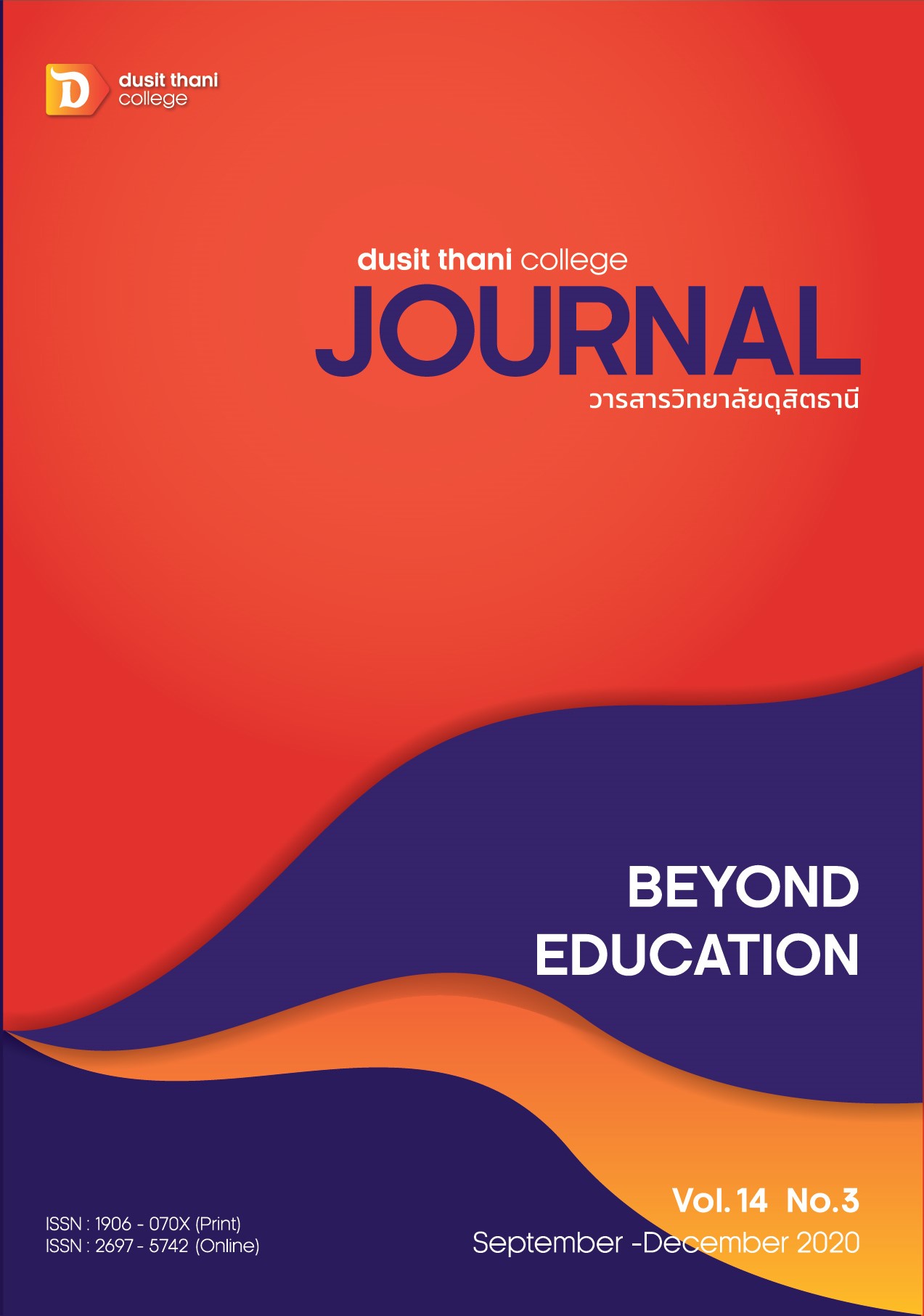การตลาดสำหรับองค์กรเพื่อการกุศล: ปัจจัยที่มีผลต่อการจูงใจเพื่อบริจาคเงินผ่านช่องทางออนไลน์เพื่อการศึกษาของคนรุ่นต่อไป
Main Article Content
บทคัดย่อ
ความก้าวหน้าของการสื่อสารผ่านอินเทอร์เน็ตได้เพิ่มประสิทธิภาพและกระแสเงินสดรับให้กับองค์กรต่าง ๆ ซึ่งรวมถึงองค์กรเพื่อการกุศล ส่งผลให้เกิดการเปลี่ยนแปลงของกระบวนการดำเนินงาน เช่น การรับบริจาคเงินผ่านช่องทางออนไลน์แทนการตั้งกล่องรับบริจาค นอกจากนี้คุณภาพและความละเอียดของข้อมูลที่ได้จากการสื่อสารผ่านอินเทอร์เน็ตได้ช่วยให้องค์กรการศุกลเข้าใจพฤติกรรมของผู้บริจาคเงินผ่านช่องทางออนไลน์มากขึ้น งานวิจัยฉบับนี้จัดทำขึ้นเพื่อศึกษาปัจจัยที่มีผลต่อการจูงใจเพื่อบริจาคเงินผ่านช่องทางออนไลน์ ผ่านปัจจัยที่มีผลต่อความสำเร็จของโครงการเพื่อการกุศลในแง่ของการได้รับเงินบริจาคตามเป้าหมายที่กำหนดไว้ โดยศึกษาจากกลุ่มตัวอย่างจำนวน 332,281 ชุด จากโครงการเพื่อการกุศลของโรงเรียนทั่วประเทศสหรัฐอเมริการะหว่างปี ค.ศ. 2000-2016 ซึ่งเรี่ยไรเงินการกุศลผ่านช่องทางออนไลน์ในเว็บไซต์ “DonorsChoose” โดยใช้วิธีการวิเคราะห์การถดถอยพหุคูณ (multivariable logistic regression) เพื่อศึกษาปัจจัยที่มีผลต่อความสำเร็จของโครงการฯ ซึ่งสะท้อนถึงพฤติกรรมการบริจาคเงินผ่านช่องทางออนไลน์ ผลการศึกษาพบว่าปัจจัยที่มีผลต่อความสำเร็จของโครงการฯ ได้แก่ จำนวนนักเรียนที่โครงการฯ ครอบคลุม ฐานะของโรงเรียน ประเภทของโครงการ จำนวนเงินบริจาคที่โครงการฯ ตั้งเป้าไว้ ระดับการศึกษาของนักเรียน และแนวทางการให้เงินสมทบยอดบริจาค ซึ่งเป็นปัจจัยที่มีความสำคัญสูงสุดหากเทียบกับปัจจัยอื่น ๆ ที่กล่าวมาข้างต้น นอกจากนี้ โครงการเพื่อการกุศลที่รับเงินบริจาคเพื่อนำไปใช้เป็นค่าใช้จ่ายในการเดินทาง จะมีโอกาสประสบความสำเร็จมากกว่าโครงการประเภทอื่น ๆ รวมทั้ง โครงการเพื่อการกุศลที่รับเงินบริจาคเพื่อนำไปให้นักเรียนช่วงชั้น 9 ถึง 12 จะมีโอกาสประสบความสำเร็จมากกว่าโครงการที่รับเงินบริจาคเพื่อนำไปให้นักเรียนในช่วงชั้นอื่น ๆ ที่ต่ำกว่า ดังนั้น จากผลการศึกษา ผู้วิจัยสนับสนุนให้องค์กรเพื่อการกุศลใช้วิธีการสมทบเงินบริจาคในการทำการตลาดเพื่อเพิ่มแรงจูงใจให้ผู้ที่บริจาคเงินและผู้ที่สนใจบริจาคเงินผ่านช่องทางออนไลน์
Article Details
นโยบายการพิจารณากลั่นกรองบทความ
- บทความวิจัยและบทความวิชาการทุกเรื่องที่จะได้รับการตีพิมพ์ต้องผ่านการพิจารณากลั่นกรองโดยผู้ทรงคุณวุฒิ (Peer Review) ในสาขาที่เกี่ยวข้อง จำนวน 3 ท่าน/บทความ
- บทความ ข้อความ ภาพประกอบและตารางประกอบที่ลงตีพิมพ์ในวารสารเป็นความคิดเห็นส่วนตัวของผู้เขียน กองบรรณาธิการไม่จำเป็นต้องเห็นด้วยเสมอไป และไม่มีส่วนรับผิดชอบใด ๆ ถือเป็นความรับผิดชอบของผู้เขียนแต่เพียงผู้เดียว
- บทความที่จะได้รับการตีพิมพ์จะต้องไม่เคยตีพิมพ์ เผยแพร่ที่ใดมาก่อน และไม่อยู่ระหว่างการพิจารณาของวารสารฉบับอื่น หากตรวจสอบพบว่ามีการตีพิมพ์ซ้ำซ้อน ถือเป็นความรับผิดชอบของผู้เขียนแต่เพียงผู้เดียว
- บทความใดที่ผู้อ่านเห็นว่าได้มีการลอกเลียนหรือแอบอ้างโดยปราศจากการอ้างอิง หรือทำให้เข้าใจผิดว่าเป็นผลงานของผู้เขียน กรุณาแจ้งให้กองบรรณาธิการวารสารทราบจะเป็นพระคุณยิ่ง
เอกสารอ้างอิง
The cause marketing paradox. Journal of Consumer Psychology, 21(3), 338-345.
Best Charles (2020, March 31). DonorsChoose: Support a classroom. Build a future. https://www.donorschoose.org/data.
Christine M. B., Hakkyun K. and Barbara L. (2013). Corporate sponsorships may hurt nonprofits: Understanding their effects on charitable giving. Journal of Consumer Psychology, 23(3), 288-300.
Daniel Teles. (2016). Do Tax Credits Increase Charitable Giving? Evidence from Arizona and Iowa. Proceedings. Annual Conference on Taxation and Minutes of the Annual Meeting of the National Tax Association, 109, 1-76.
Daniel W. E., Ray F. and Brian M. (2012). Charity as a Substitute for Reputation: Evidence from an Online Marketplace. The Review of Economic Studies, 79(4), 1441-1468.
Dean K. and John A. L. (2007). Does Price Matter in Charitable Giving? Evidence from a Large-Scale Natural Field Experiment. The American Economic Review, 97(5),
1774-1793.
Farnoosh K., J. Andrew P. and Rajkumar V. (2015). Developing Donor Relationships:
The Role of the Breadth of Giving. Journal of Marketing, 79(4), 77-93.
Gabrielle F. and Camille L. (2010). Are Tax Incentives for Charitable Giving Efficient? Evidence from France. American Economic Journal: Economic Policy, 2(2), 117-141.
Karen Page W., Vikas M. and William T. Ross JR. (2009). Donation Behavior toward
In‐Groups and Out‐Groups: The Role of Gender and Moral Identity.
Journal of Consumer Research, 36(2), 199-214.
Karen Page W., Vikas M. and Karl A. (2013). When Does Recognition Increase Charitable Behavior? Toward a Moral Identity-Based Model. Journal of Marketing, 77(3), 121-134.
Lalin A., Machael I. N. and Dan A. (2014). Contingent Match Incentives Increase Donations. Journal of Marketing Research, 51(6), 790-801.
Matthew Chao. (2017). Demotivating incentives and motivation crowding out in charitable giving. Proceedings of the National Academy of Sciences of the United States of America ,114(28) 7301-7306.
Michelle H. Y. and Robert J. Y. (2013). How Does the Incentive Effect of the Charitable Deduction Vary across Charities?. The Accounting Review, 88(3), 1069-1094.
Naomi E. F. (2010). Time is Money: Choosing between Charitable Activities.
American Economic Journal: Economic Policy, 2(1), 103-130.
Richard H. (2012). From Web Site Visitor to Online Contributor: Three Internet Fundraising Techniques for Nonprofits. Social Work, 57(4), 361-365.
Sarah Smith. (2012). Increasing Charitable Giving: What Can We Learn from Economics?. Fiscal Studies, 33(4), 449-466.
Steffen H., Imran R. and Andrew S. (2015). Comparing Charitable Fundraising Schemes: Evidence from a Natural Field Experiment and a Structural Model.
American Economic Journal: Economic Policy, 7(2), 326-369.
Walter Wymer and Tanya Drollinger. (2015). Charity Appeals Using Celebrity Endorsers: Celebrity Attributes Most Predictive of Audience Donation Intentions. Voluntas: International Journal of Voluntary and Nonprofit Organizations, 26(6), 2694-2717.
Wendy L. and Jennifer A. (2008). The Happiness of Giving: The Time-Ask Effect. Journal of Consumer Research, 35(3), 543-5.


